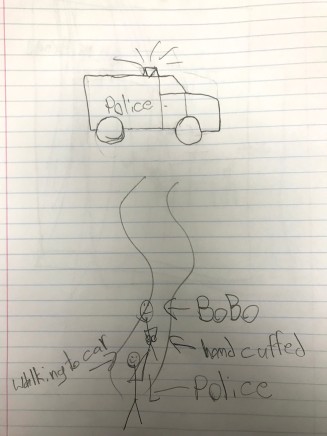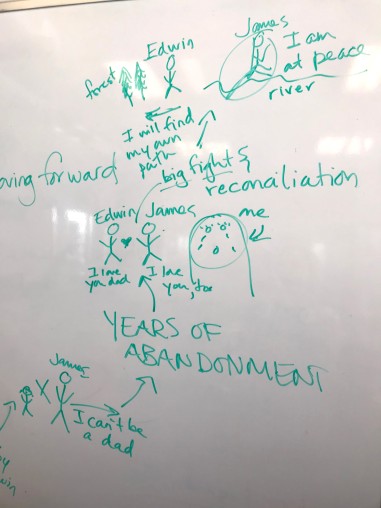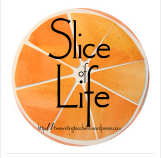Paula Borque over at litcoachlady has been offering a wonderful list of ways to spark writing all month long. I’ve been tucking some away, trying some myself and sharing some with my students. On day 18, Paula shared an idea about using sketchnoting to synthesize our reading. Since I’ve been actively trying to incorporate sketchnoting in my classes, I was instantly intrigued.
My students are in Grade 10 and many (though not all) arrive in my class without a strong reading base. They will admit to reading few or no books for several years, to fake reading, to avoiding writing and more. I’ve been using choice reading with conferencing to assess their understanding and development as readers, but all of this is mediated through words. I wondered what would happen if I used Paula’s spark and asked my students to sketch something from their reading after our independent reading time. The results were fascinating.
Some students clearly understand what they are reading. Below, I can see this student’s focus on character relationships, plot and even some emerging theme in Harry Potter and the Prisoner of Azkaban.
The next student is reading HP Lovecraft (!) and his sketchnote highlights his focus on sentence structure and diction. He chose to sketch a two-sentence paragraph that he found hard to understand because of its diction and complex structure. Afterwards, he said that sketching helped him figure out what it meant.
Another fascinating moment was this one, where a student who is really a novice reader tried sketching a moment from Monster. He originally thought that Mr. Harmon was the judge, but as he drew, he realized something didn’t fit. We spoke briefly, looked at the text, and learned that Mr. Harmon was the father not the judge. He was talking to his son in the visiting area of the prison. This sketchnote helped him clarify his understanding and helped me see his gaps.
The next day, that same student picked up far more details as he read:

Finally, one of my English Language Learners spends her independent reading time working with our (amazing, generous, talented) librarian on language development. Right now we’re specifically working on English vocabulary for everyday words in her home, since her family doesn’t speak English. Rather than sketch her understanding of a book, she sketched a room in her house and labeled as many items as she could. Then I was able to sit with her and identify some errors and add a few new words. This was incredibly effective. I was able to see that she hears/says “belw” for “pillow” and “cheer” for “chair.” Her pronunciation of those words improved almost immediately once we recognized this. Moving from “rog” to “rug” was harder. We also added “dresser” “sheets” and “bedspread” to her lexicon. Baby steps.

To be clear, I didn’t just walk into class and say, “Hey guys, draw today.” First, I sketchnoted my own reading – the graphic novel 7 Generations – alongside my students. We talked about my choices in terms of plot, character, important ideas and images. I’m never going to win any awards for my art, but I think the students felt better knowing that I really wasn’t looking for perfection.

Then, we did it three days in a row so that they had a chance to really “get it.” Some students moved quickly back to writing – no drawing for them, thank you very much – but others stuck with sketchnotes. In the end, I think that sketchnoting our understanding of our reading expanded the way some students could express themselves and let them show me what they know in a way that isn’t exclusively mediated by words. Sketchnoting let me see some of the processes of student comprehension. It feels like this is another tool in my toolkit to help develop proficient readers. Thanks, Paula.



The way you modeled your work is what helped push the students to think through their sketches. I may try this out after break.
LikeLike
It was funny to draw in front of them – it’s not my strong suit & they kind of loved it – but I think that it really helped.
LikeLiked by 1 person
OH, MYLANTA! This is fantastic! I think your modeling gave them the confidence that it didn’t have to look polished and perfect. I was amazed at the ways kids used it to work through their thinking at so many different levels. Talk about differentiation! I am so heartened that you gave this a try and stuck with it for a few days to help them “get it”. Some students won’t embrace this, but for those who need another tool to process thinking you’ve just given them such a gift. Thank you for posting this Amanda. You’ve made my whole week!!
LikeLike
Thank YOU! I love anything that helps improve thinking & this definitely fits that bill. Now, to try out some of your other amazing ideas…
LikeLike
I really like this idea. I am not that great at sketch noting because I need to see the whole piece of art in my head before it goes on paper. (Not to imply I’m a great artists!) I like the way this lets kids put their thinking on paper though. Maybe I’ll give it a try.
LikeLike
Great slice, Amanda, and a wonderful peak into how you worked with this with your students. I’m working on the brochure for my Oct poetry workshop,.. so when I read your post, I made immediate connections. I use sketch noting with oral renditions of poetry in the elementary grades. Actually we break it apart… sketching the first day without words. Then on day two, we label our sketches with words used in the poem that made us think of that part of the sketch. The labeling is followed by a sharing time. In addition to giving me a window into their comprehension, they are developing a myriad of literacy skills — non-linguistic representations (Marzano), visualization, listening, inference… and so much more. Perhaps the less obvious is the note taking skills. Sketchnoting from reading is note taking from printed media; sketchnoting from a read aloud is note taking from oral media. You made me remember some PD I did years ago with a HS English department. I made large whiteboards from a shower board (you can get 4 out of a single shower board). Each group of four pushed their chairs together so the tablet arms could support the whiteboard. Each group got a set of dry erase markers; I required each student to select a color that they had to use (so they would all write or sketch something on the board). I did a read aloud (with some stop places) without any input from me. Each small group did sketchnoting collaboratively on the whiteboard…. oh no, I’m writing a post in your comments. LOL.
LikeLike
I love seeing these big kid examples. We’ve been trying this type of note taking for nonfiction reading. I think it’s been really successful for some students. I love the work with the student learning English. Your examples show the difference that this work is making with her learning.
LikeLike
I’ve always wanted to try Sketchnoting so this is pretty cool! I’m impressed
LikeLike
I have also been inspired by Paula Bourque’s posts. I love how you took this idea and adapted it to the very specific and different needs of your students. And of course, so much value in your modeling.
LikeLike
Your words combined with student work makes for a slice that reveals new entry points into all things literacy, literate, and literary. Have you come across BookSnaps in your digital travels? They strike me as an offshot of the process you’re dabbling in. More here: https://www.tarammartin.com/resources/booksnaps-how-to-videos/
LikeLike
I’ve heard of booksnaps but never seen or used them. Off to explore your link!
LikeLike
It’s funny how things have disappeared from and reappeared in my repertoire of teaching/learning strategies over the years. It’s like the file cabinet in my head needs to push the back files to the front every so often. Thanks for the reminder of a great tool for students (and I think the graphics make the gaps more obvious to teachers). My students just decided to write a persuasive letter to our principal, asking for more art time during the day. I think I may just be able to swindle them into thinking this is a little bit of “art” during reading.
LikeLike
I have the same things – ideas that swirl in and out of my teaching. I’m betting your kids will totally fall for this art in reading.
LikeLiked by 1 person